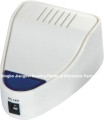1 / 5
Útiles para el hogar de RIDDEX Bed Bug Zapper
| Model No. : | ZT09032 |
|---|---|
| Brand Name : | RIDDEX |

Descripción del Producto
Riddex Bug disuasorio utiliza ondas de ultrasonido para interrumpir el ciclo reproductivo de los ácaros del polvo. Reclamar su colchón de ácaros del polvo no deseados mientras que ahorra miles de dólares.
Función:
1 reduce el riesgo de asma y otras alergias
2. inofensivo para mascotas y los seres humanos.
3.Non tóxico y respetuoso del medio ambiente.
4 eficaz contra las chinches y dustmites
5 resultados en tan poco como 4 semanas
6 no interferirá con la electrónica
7 tensión nominal: 110-240V
8.Frequency: 50-60HZ
|
What are mites? These mites live in house dust and in beddings like mattresses, blanket and pillows, feeding on epithelial dander.
What is house dust mite allergy? House dust mites (Fig. 2) are found in all homes. They are microscopic organisms that thrive in warm and humid houses with lots of food - human skin. The mites prefer to live in beds and, because we spend about a third of the day in bed, we inhale large quantities of dust mite allergens.
How do you become allergic to house dust mites? Unlike pollen, dust mites are present all year round causing constant allergy - 'perennial' allergic rhinitis. The excretion from the mites dries out and can be launched into the air when someone walks over a rug, sits down in a chair, or shakes the bed clothes, giving allergic people immediate symptoms.
What are the symptoms of house dust mite allergy? 
  
|
Envíe su consulta a este proveedor





































